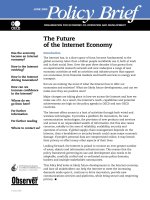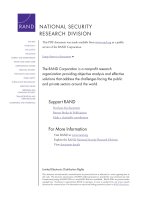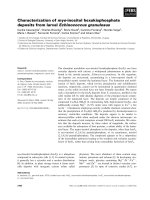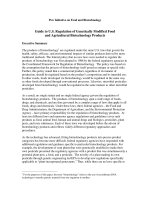The Future of Genetically Modified Crops - Lesson from the Green Revolution pdf
Bạn đang xem bản rút gọn của tài liệu. Xem và tải ngay bản đầy đủ của tài liệu tại đây (1.02 MB, 116 trang )
This PDF document was made available
from
www.rand.org as a public service of
the RAND Corporation.
6
Jump down to document
Visit RAND at www.rand.org
Explore RAND-Initiated Research
View document details
This document and trademark(s) contained herein are protected by law
as indicated in a notice appearing later in this work. This electronic
representation of RAND intellectual property is provided for non-
commercial use only. Permission is required from RAND to reproduce, or
reuse in another form, any of our research documents.
Limited Electronic Distribution Rights
For More Information
CHILD POLICY
CIVIL JUSTICE
EDUCATIO
N
ENERGY AND ENVIRONMENT
HEALTH AND HEALTH CAR
E
INTERNATIONAL AFFAIR
S
NATIONAL SECURIT
Y
POPULATION AND AGIN
G
PUBLIC SAFETY
SCIENCE AND TECHNOLOGY
SUBSTANCE ABUSE
TERRORISM AND
HOMELAND SECURITY
TRANSPORTATION AND
INFRASTRUCTURE
The RAND Corporation is a nonprofit
research organization providing
objective analysis and effective
solutions that address the challenges
facing the public and private sectors
around the world.
RAND-INITIATED RESEARCH
Purchase this document
Browse Books & Publications
Make a charitable contribution
Support RAND
This product is part of the RAND Corporation monograph series.
RAND monographs present major research findings that address the
challenges facing the public and private sectors. All RAND mono
-
graphs undergo rigorous peer review to ensure high standards for
research quality and objectivity.
The Future of
Genetically
Modified Crops
Lessons from the Green Revolution
FELICIA WU
WILLIAM P. BUTZ
The RAND Corporation is a nonprofit research organization providing
objective analysis and effective solutions that address the challenges
facing the public and private sectors around the world. RAND’s
publications do not necessarily reflect the opinions of its research clients
and sponsors.
R
®
is a registered trademark.
© Copyright 2004 RAND Corporation
All rights reserved. No part of this book may be reproduced in any
form by any electronic or mechanical means (including photocopying,
recording, or information storage and retrieval) without permission in
writing from RAND.
Published 2004 by the RAND Corporation
1700 Main Street, P.O. Box 2138, Santa Monica, CA 90407-2138
1200 South Hayes Street, Arlington, VA 22202-5050
201 North Craig Street, Suite 202, Pittsburgh, PA 15213-1516
RAND URL: />To order RAND documents or to obtain additional information, contact
Distribution Services: Telephone: (310) 451-7002;
Fax: (310) 451-6915; Email:
Library of Congress Cataloging-in-Publication Data
Wu, Felicia.
The future of genetically modified crops : lessons from the Green Revolution /
Felicia Wu and William Butz.
p. cm.
“MG-161.”
Includes bibliographical references.
ISBN 0-8330-3646-7 (pbk.)
1. Transgenic plants. 2. Crops—Genetic engineering. 3. Green revolution.
I. Butz, William P. II. Title.
SB123.57.W8 2004
631.5'233—dc22
2004014614
Cover design by Peter Soriano
This research in the public interest was supported by RAND, using
discretionary funds made possible by the generosity of RAND’s donors
and the fees earned on client-funded research.
iii
Preface
The number of people in danger of malnutrition worldwide has de-
creased significantly in the past 30 years, thanks in part to the Green
Revolution of the 20th century. However, an estimated 800 million
people still lack adequate access to food. The world now sits at the
cusp of a second potential agricultural revolution, the “Gene Revolu-
tion” in which modern biotechnology enables the production of ge-
netically modified (GM) crops that may be tailored to address ongo-
ing agricultural problems in specific regions of the world. The GM
crop movement has the potential to do enormous good, but also pre-
sents novel risks and has significant challenges to overcome before it
can truly be considered revolutionary. This monograph seeks to an-
swer these questions: Can the Gene Revolution become in fact a
global revolution, and, if so, how should it best proceed?
This report draws on lessons from the Green Revolution to in-
form stakeholders who are concerned with the current GM crop
movement. We hope that this analysis can illuminate opportunities
for GM crops to increase farm production, rural income, and food
security in developing countries, while controlling potential risks to
health and the environment. The analysis and findings in this report
are intended for all individuals and institutions interested in improv-
ing agricultural production and food quality in the developing world,
and particularly those who have a stake in the worldwide debate over
genetically modified crops.
This report results from the RAND Corporation’s continuing
program of self-sponsored independent research. Support for such
iv The Future of Genetically Modified Crops
research is provided, in part, by donors and by the independent re-
search and development provisions of RAND’s contracts for the op-
eration of its U.S. Department of Defense federally funded research
and development centers.
Questions about this report should be directed to Felicia Wu at
the University of Pittsburgh, Graduate School of Public Health,
A718 Crabtree Hall, 130 DeSoto St., Pittsburgh, PA 15261 (fwu@
eoh.pitt.edu).
v
The RAND Corporation Quality Assurance Process
Peer review is an integral part of all RAND research projects. Prior to
publication, this document, as with all documents in the RAND
monograph series, was subject to a quality assurance process to ensure
that the research meets several standards, including the following:
The problem is well formulated; the research approach is well de-
signed and well executed; the data and assumptions are sound; the
findings are useful and advance knowledge; the implications and rec-
ommendations follow logically from the findings and are explained
thoroughly; the documentation is accurate, understandable, cogent,
and temperate in tone; the research demonstrates understanding of
related previous studies; and the research is relevant, objective, inde-
pendent, and balanced. Peer review is conducted by research profes-
sionals who were not members of the project team.
RAND routinely reviews and refines its quality assurance pro-
cess and also conducts periodic external and internal reviews of the
quality of its body of work. For additional details regarding the
RAND quality assurance process, visit />standards/.
vii
Contents
Preface iii
Figures
xi
Tables
xiii
Summary
xv
Acknowledgments
xxv
Acronyms
xxvii
CHAPTER ONE
Introduction 1
The Agricultural Revolutions of the 19th and 20th Centuries
2
The "Gene Revolution"
4
The Gene Revolution in Light of the Earlier Green Revolution
5
Science and Technology
6
Funding and Sources of Financial Investment
6
Where the Revolution Takes Place
7
Policies and Politics
8
Organization of This Report
8
CHAPTER TWO
The Green Revolution 11
Science and Technology
12
Plant Breeding Methodologies
13
Combined Technologies
14
Training of Local Scientists
15
Funding
15
viii The Future of Genetically Modified Crops
Where the Green Revolution Occurred 18
Latin America
18
Asia
19
The United Kingdom
22
A Failure in Africa?
23
Policies and Politics
26
Domestic Interests
26
International Interests
28
Where the Green Revolution Fell Short: Remaining Challenges
30
Agricultural Challenges
30
Human Health Challenges
32
Socioeconomic Challenges
33
Environmental Challenges
35
Lessons from the Green Revolution
36
Successes of the Green Revolution
36
Issues Left Unresolved by the Green Revolution
37
CHAPTER THREE
The Gene Revolution: Genetically Modified Crops 39
Science and Technology
40
Agricultural Benefits of Genetically Modified Crops
41
Potential Health Benefits of GM Crops
42
Potential Risks of GM Crops
44
Funding
45
Where the Gene Revolution Is Occurring
49
Policies and Politics
53
United States
54
European Union
57
The U.S. and EU Dispute over GMOs and Its Implications for the
Gene Revolution in the Developing World
59
Other Crucial Differences in the Political Worlds of the Green and
Gene Revolutions
62
Contents ix
CHAPTER FOUR
Lessons for the Gene Revolution from the Green Revolution 65
Agricultural Biotechnology Is Just One of Several Options for the
Future
66
Broadening the Impact of the GM Crop Movement: Applying Lessons
from the Green Revolution
68
Implications for Relevant Stakeholders
74
Bibliography
77
xi
Figures
2.1. Total Production of Maize and Wheat in Latin America and
the Caribbean, 1961 to 1991
19
2.2. Total Rice Production in East and Southeast Asia, 1961
to 1991
21
2.3. Total Wheat and Rice Production in South Asia, 1961 to
1991
22
2.4. Annual Growth Rates in Yield for Rice, Wheat, and Maize in
China, 1966 to 1995
31
3.1. Area Devoted to Genetically Modified Crops, 1996 to 2003
51
xiii
Tables
2.1. Changes in Production Inputs in India, Pakistan, and China
Due to the Green Revolution
14
2.2. Change in Percentage of the Chronically Malnourished
Population in Developing Countries, 1970 to 1990
25
2.3. Publicly Funded Agricultural Research, by Country, Crop, and
Year Research Began
25
3.1. Current and Potential Benefits of Genetically Modified Crops
44
3.2. Regulatory Scheme for Coordinating Reviews of GM Crops
55
3.3. Impact of Bt Corn on U.S. Stakeholders
63
xv
Summary
The world now sits at the cusp of a new agricultural revolution—the
“Gene Revolution” in which modern biotechnology enables the pro-
duction of genetically modified (GM) crops that may be tailored to
address agricultural problems worldwide. This report investigates the
circumstances and processes that can induce and sustain such an agri-
cultural revolution. It does so by comparing the current GM crop
movement with the Green Revolution of the latter half of the 20th
century. We assess not only the scientific and technological differ-
ences in crops and in agricultural methods between these two move-
ments, but more generally the economic, cultural, and political fac-
tors that influence whether a new agricultural technology is adopted
and accepted by farmers, consumers, and governments. Our historical
analysis of the earlier Green Revolution provides lessons about
whether and how genetically modified crops might spread around the
world. Whether the latter movement will develop into a global Gene
Revolution remains to be seen.
Genetically modified crops created by modern agricultural bio-
technology have attracted worldwide attention in the past decade.
Cautious voices warn that the health and environmental effects of
GM crops are uncertain and that their cultivation could have unin-
tended adverse consequences. Alternatively, supporters of the tech-
nology assert that GM crops could revolutionize world agriculture,
particularly in developing countries, in ways that would substantially
reduce malnutrition, improve food security, and increase rural in-
come, and in some cases even reduce environmental pollutants.
xvi The Future of Genetically Modified Crops
Can the GM crop movement develop into an agricultural revo-
lution on the scale of the Green Revolution? To answer this question,
first, it is important to consider what an agricultural revolution en-
tails. Viewed historically, movements that come to be considered ag-
ricultural revolutions share the following features:
1. The movements gave farmers incentives to produce—i.e., the
technologies provided a net benefit to farmers.
2. The movements substantially improved agricultural production,
food nutrition, or both; or they substantially decreased necessary
inputs such as fertilizer or water.
3. People were generally willing to adapt culturally and economically
to the new technologies, and consumers accepted the products of
the agricultural movement.
4. There was cooperation among those that provided the technolo-
gies, regulated the technologies, and used the technologies.
5. The movements were sustainable, eventually without public sub-
sidization.
On a regional scale, GM crops might indeed be considered
revolutionary—that is, they could meet all five criteria for an agricul-
tural revolution. In the United States, Canada, China, and Argentina,
for example, genetically modified varieties of soybeans, corn, and cot-
ton now make up from about a third to 80 percent of total plantings
of those crops, and provide benefits for growers such that these GM
varieties will likely continue to make up a substantial portion of total
plantings in the foreseeable future. Likewise, policymakers and the
general public in these nations are accepting of this new technology.
Adoption of these GM crops has led to improved yield, decreased use
of pesticides or particularly harmful herbicides, and, in some cases,
improved food quality.
While farmers in other nations, such as India and South Africa,
have more recently begun to plant GM crops and experience the be-
ginnings of a potential Gene Revolution, the revolution has yet to
occur on a global scale. It has stalled because consumer and environ-
Summary xvii
mental concerns, along with precautionary regulations, have limited
its spreading to the countries that could benefit from it most, notably
much of sub-Saharan Africa where famine continually threatens the
population.
As stated above, the purpose of this report is to better under-
stand whether and how this GM movement might become an
authentic agricultural revolution by comparing it with an earlier agri-
cultural movement that did reach nearly the entire world. The Green
Revolution that had its origins in the 1940s, and reached its peak in
the 1970s, continues to affect agricultural practices today. By analyz-
ing the Green Revolution’s objectives, science and technology,
sources of financing, regulatory environment, and ultimate successes
and failures, we offer an assessment of the ongoing GM crop move-
ment—whether and how it might make a revolutionary impact on
world agriculture.
The stated objective of the Green Revolution was to increase
food production in regions of the world facing impending massive
malnutrition. In the post-World War II era, scientists and policy-
makers considered those regions to be Latin America and Asia. Some
argue, in retrospect, that this geographic choice was also motivated by
Cold War politics: a largely U.S supported effort to prevent the
spread of communism by ensuring adequate food supplies in at-risk
countries.
Regardless of its motivation, the introduction of high-yield va-
rieties (HYVs) of crop seed, along with pesticides, fertilizers, and irri-
gation systems, transformed agriculture on those two continents.
With initial funding from the Rockefeller Foundation, individuals
including U.S. plant breeders, agronomists, entomologists, soil scien-
tists, and engineers worked in developing nations while training local
agricultural scientists to extend the work in their own locales. The
World Bank, Food and Agricultural Organization of the United Na-
tions (FAO), United States Agency for International Development
(USAID), and other national and international organizations later
joined the Rockefeller Foundation to make this effort succeed. And
succeed it did, in terms of increasing food production in Asia, Latin
America, and even parts of the industrialized world such as Great
xviii The Future of Genetically Modified Crops
Britain. In Africa, however, where the movement came later, the
Green Revolution has yet to improve food production in a sustain-
able way. As such, this movement provides several important lessons
for understanding the possible course of the Gene Revolution.
We compare the Green Revolution and the current GM crop
movement in four basic areas: science and technology, funding
sources, where the movement occurred or is occurring, and the poli-
cies and political motivations surrounding each movement.
Science and Technology
The Green Revolution presented a considerable advance in agricul-
tural technologies for farmers in the developing world, and, to a lim-
ited extent, in industrialized countries as well. For the first time, sci-
entists and plant breeders integrated their research with farming
practices in traditional agriculture to tackle problems that were con-
straining crop yield. High-yield seeds for rice, wheat, and corn were
introduced in parts of the world where these crops made up a signifi-
cant portion of the daily diet, and subsequently of food exports. Pes-
ticides, chemical fertilizers, and irrigation systems were also intro-
duced to aid farmers in controlling previously unmanageable pests,
dealing with low-quality soil, and delivering water to crops according
to their requirements.
The Gene Revolution, propelled by genetic engineering, allows
previously unheard-of combinations of traits across species to achieve
pre-specified objectives. For example, daffodil and bacterial genes can
be introduced into the rice genome so that the rice produces beta-
carotene, the precursor of vitamin A. The benefits of the current va-
rieties of GM crops include yield increase, reduced agricultural inputs
such as pesticides and fertilizers, reduced vulnerability to the whims
of nature, and improved nutritional content. For the most part, these
benefits have been limited to parts of the industrialized world to
which current GM crop development and marketing have been tar-
geted and, among those, to countries that have allowed their cultiva-
tion. Other GM crops are now being developed that survive on less
Summary xix
water, that survive in soil heavy in salt or metals such as aluminum,
that convert or “fix” nitrogen from the air, and that produce vaccines
against common diseases such as cholera and hepatitis B (Byrne et al.,
2004).
A fundamental challenge in this newest agricultural movement
that did not arise during the Green Revolution is the definition and
treatment of intellectual property (IP). IP issues are central to the
Gene Revolution because whereas science and technology move for-
ward through the sharing of ideas and resources, IP ambiguities and
restrictions can often limit the valuable diffusion of science and tech-
nology. Commercial application of biotechnology has taken place
primarily in the United States and primarily through the private sec-
tor. The issue of who “owns” a particular event (the successful trans-
formation) of a genetically modified crop and who can develop it fur-
ther has become so economically important and contentious that
numerous cases involving this issue are being litigated (Woodward,
2003). Some observers consider IP issues to be among the most im-
portant impediments to the development and adoption of GM crops
in the developing world (Shoemaker et al., 2001; Cayford, 2004).
Patent rights that universities may have on their sponsored research,
corporate profit interests, and the ability of farmers to buy IP-
protected seed are salient IP issues.
Funding
Philanthropic organizations, i.e., the Rockefeller and Ford Founda-
tions, provided the backbone of early funding for the Green Revolu-
tion (Perkins, 1997; Pinstrup-Andersen and Schioler, 2001). The sci-
entists who created high-yield seeds and their associated pesticides
and fertilizers worked in conjunction with, and were funded by, these
foundations along with the governments of Mexico, India, and sev-
eral other countries. In 1971, while the Green Revolution was bear-
ing its first fruits in many parts of the world, the Consultative Group
on International Agricultural Research (CGIAR)—a system of 16 Fu-
ture Harvest Centers working in more than 100 countries—was cre-
xx The Future of Genetically Modified Crops
ated. With the creation of CGIAR, support for developing world ag-
riculture became more broad-based and included European nations,
Canada, and Japan.
Genetically modified crops are largely the product of private in-
dustry. This is partly because new technologies are far more costly
than existing ones, and the biotechnology industry was able to gather
the necessary funds to develop these technologies long before public
awareness of GM crops could lead to publicly generated funding for
GM crop development (Pinstrup-Andersen and Schioler, 2001). Suc-
cessful companies typically focus on their markets with the intent of
generating profit. With regard to agricultural biotechnology, compa-
nies in the United States and elsewhere have thus far created primar-
ily seeds that farmers in industrialized countries can and will pur-
chase: corn and soybeans that can tolerate a particular herbicide, corn
and cotton that are resistant to particular pests, and food crops that
last longer on the supermarket shelf. Because of the “technology fee”
that growers pay to use these crop seeds (including recoupment of
industry’s research and development costs as well as profit), and be-
cause the seeds are designed particularly for their planting situations,
the targeted farmers in industrial countries have generally found it
worthwhile to buy these seeds and have been willing to pay the tech-
nology fee (Wu, 2004). Thus, in industrialized nations, GM crop
technology has had the potential to revolutionize farming. However,
the current GM crop seed varieties are neither affordable nor useful
to most of the poorer farmers in the world; hence, their revolutionary
impact in the developing world has been limited thus far. Indeed,
there seems to be a mismatch of setting and technology, due to the
funding sources of basic research.
Some agricultural biotechnology companies have recently ex-
pressed interest in working with regional research institutions to de-
velop crops that would be profitable and affordable for farmers in de-
veloping countries. In addition, they are willing to donate a
substantial portion of their scientific knowledge, such as genomes of
key food crops, to increase agricultural knowledge in the developing
world. In this way, the challenges related to IP may be lessened.
Summary xxi
Where the Revolution Was and Is Taking Place
The Green Revolution was a success, in terms of its stated objectives,
in Mexico and the rest of Latin America, India, and much of South-
east Asia. On the other hand, the Green Revolution has had little sig-
nificant impact in most areas of Africa. Two prominent hypotheses
for this outcome are that the technology package that was so useful in
some parts of the world was not applicable to African farms, and that
rural transportation systems are ill-designed to deliver either the tech-
nologies or their resulting products.
The technologies introduced in Asia and Latin America in the
Green Revolution generally required not more land, but chemical
fertilizer and well-timed water. Farmers who could access these inputs
did well while others did not. To the extent that large landholders
also had access to fertilizer and irrigation, they tended to adopt the
new technologies early and successfully.
It may be too early to predict the varying adoption rates and
benefits of yet undeveloped Gene Revolution technologies given the
differing characteristics of farmers and regions. What can be said
from the Green Revolution experience is that farmers will not adopt
and utilize technologies over the long term that do not cost consid-
erably less than current technologies, produce considerably more than
current technologies, or substantially reduce the variability of cost or
production in their own locales. As opposed to the Green Revolution,
the key component of the Gene Revolution technology is improved
seed. This being the case, all farmers, small or large, should be able to
take advantage of the Gene Revolution; theoretically, the Gene
Revolution is scale-neutral, providing that one can pay for the seed.
However, cultural factors may deter farmers from embracing the new
science; genetically modified crops have already become a stigmatized
technology in some parts of the world because of concerns about ma-
nipulating organisms in seemingly “unnatural” ways and fears of un-
intended adverse impacts on the environment or human health.
xxii The Future of Genetically Modified Crops
Policies and Politics
At the time the Green Revolution was first seriously considered, the
United States and the rest of the developed world feared that food
crises in developing countries would cause political instability that
could push those countries over to the Communist side (Perkins,
1997). Partly as a result of this issue, the U.S. government was highly
concerned about agricultural science in the developing world and
worked with foundations and scientists in the post-World War II
decades to bring about the Green Revolution in regions subject to
famine.
As of yet, there does not appear to be a strong political motiva-
tion for genetically modified crops to succeed in the developing
world. Communism is no longer a threat, and famines, while still a
problem in parts of the world, appear to be more the result of local-
ized weather, politics, and war conditions than a sweeping threat that
commands sustained government and public attention in industrial
countries. Instead, public concerns and national and international
regulations are now the driving force behind whether GM crops are
adopted or rejected in various parts of the world, because wider pub-
lic scrutiny and the newness of the science have led to concerns about
environmental and health risks of GM crops that must be dealt with
at the policy level.
The battle between U.S. and European Union regulations,
which feature very different stances on the acceptance of GM crops in
food and feed, has been the major determinant of this outcome. In
addition, a variety of nongovernmental organizations (NGOs) that
are concerned about the influence of multinational corporations, en-
vironmental degradation, crop diversification, food safety, globaliza-
tion, and the influence of U.S. interests are prominent and influential
in both the industrialized and developing countries. These NGOs
were not nearly as influential during the Green Revolution.
Summary xxiii
Lessons from the Green Revolution
What can we determine about the prospects for the Gene Revolution
by studying the Green Revolution’s successes and failures? The Gene
Revolution thus far resembles the Green Revolution in the following
ways: (1) It employs new science and technology to create crop seeds
that can significantly outperform the types of seeds that preceded it;
(2) the impact of the new seed technologies can be critically impor-
tant to developing world agriculture; and (3) for a variety of reasons,
these technologies have not yet reached the parts of the world where
they could be most beneficial. On the other hand, the Gene Revolu-
tion is unlike the Green Revolution in the following ways: (1) The
science and technology required to create GM crop seeds are far more
complicated than the science and technology used to create Green
Revolution agricultural advancements; (2) GM seeds are created
largely through private enterprises rather than through public-sector
efforts; and (3) the political climate in which agricultural science can
influence the world by introducing innovations has changed dramati-
cally since the Green Revolution.
The similarities and differences between the Green and Gene
Revolutions lead us to speculate that for the GM crop movement to
have the sort of impact that would constitute an agricultural revolu-
tion, the following goals still need to be met and the related chal-
lenges overcome.
1. Agricultural biotechnology must be tailored toward, and
made affordable to, developing-world farmers. Unless these condi-
tions are met, farmers may not see that it is in their best interest to
use GM crops at all despite the unique benefits those crops could
provide.
2. There is a need for larger investments in research in the
public sector. Numerous studies have shown the importance of
public-sector research and development to aiding agricultural ad-
vancements, including the Green Revolution. Partnerships between
the public and private sectors can result in more efficient production
of GM crops that are useful to the developing world and can expand









